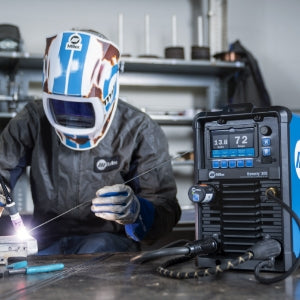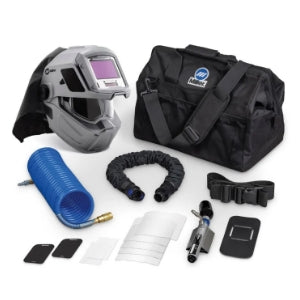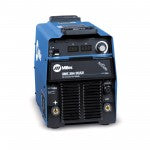We all know the importance of selecting the right tool for the job. The process you choose is as necessary as the tools themselves when it comes to welding. Different metals will require different techniques or materials; some methods are far more suited to specific jobs than others. When you're new to welding, choosing the correct method for the right job can be difficult, especially with so much to consider.
Stick Welding: (Shielded-Metal Arc)
Common Welding Processes
Today's three most common welding processes are Stick, MIG, and TIG. Each welding process has its own pros and cons that could benefit or limit you. Choosing the correct process will save you a great deal of time and frustration.
The Similarities and Differences
Unfortunately, there is no one-size-fits-all welding process. There are some significant differences between MIG, TIG, and stick welding. To get a better idea of which process is most beneficial to you in any given situation, you need to understand each process inside and out. Let's break down these three processes to help you decide which method is right for you.
Stick Welding: (Shielded-Metal Arc)
Stick welding is the oldest, simplest, and most cost-efficient of the three processes discussed in this post. Because of this, it is one of the most popular welding methods and a common choice for the beginner or hobbyist welder.
How Stick Welding Works
A consumable flux-coated rod called an electrode is used to lay the weld in stick welding. During the process, both the electrode and the metal workpiece melt, forming a weld pool. This molten pool then cools to form a sturdy joint between the two metals. Typically, welders will use pure argon gas to shield the weld, which prevents the weld pool from causing a chemical reaction with other gases.
Benefits of Stick Welding
Stick welding is fairly versatile. It can be used to weld iron, steel, aluminum, nickel, and copper alloys. It can also be performed outdoors or in windy conditions and has the rare ability to create an effective bond on rusty or unclean surfaces.
Stick Welder Safety
Additionally, unlike in MIG and TIG processes, no shielding gas is needed in stick welding because the flux coating on the electrode disintegrates during the process, emitting vapors that protect the weld from atmospheric contamination.
Downsides of Stick Welding Equipment
The major downside to stick welding is that the finished product is not nearly as ‘neat' as the other methods. Molten splatter is common and requires a fair amount of cleaning and sanding when the weld is finished. This leads to more significant costs due to the extra time spent cleaning.
The stick welding process is also very inefficient in terms of time. Between frequent electrode changes, intensive post-weld cleaning, and other similar factors, the welder spends only an estimated 25% of their time actually laying weld.
Is Stick Welding for You?
Stick welding is excellent for beginners and hobbyists because it's easy and affordable. The finished result won't be immaculate, but stick welding is your choice if you need a quick weld that isn't highly visible and doesn't require a neat bead.
Stick Welding Recommendations
The MILLER MAXSTAR 150 S — maximum portability and performance in the industry's most compact stick package. Miller is the most trusted name in welding.
The THERMAL ARC 95S TIG AND STICK WELDER — for portable Stick and TIG capabilities. It is ideal for home applications, utility/farm work, and maintenance and repair jobs.
MIG Welding: (Metal Inert Gas)
MIG stands for metal inert gas, meaning the weld uses non-reactive (inert) gases to shield the weld pool. The biggest difference between MIG and TIG welding is that MIG has an internal consumable electrode wire.
MIG welding is a relatively straightforward process, commonly requiring a week or two to master the basic technique. MIG's two most complex aspects are selecting the correct shielding gas and setting the parameters on the machine. However, once these things are taken care of, it becomes a “point-and-shoot” process, often called “the hot glue gun of welding.”
How MIG Welding Works
MIG welders use a spool gun, which feeds a spooled wire electrode at a constant speed pre-selected by the operator. The gun also emits a shielding gas as it lays the weld. This gas protects the weld area from atmospheric gases such as nitrogen and oxygen, which can cause serious problems if they come in contact with the electrode, the arc, or the welding metal.
Benefits of MIG Welding
The MIG process can create a high-strength weld with a great appearance and little need for sanding or cleaning. The use of a shielding gas allows the welder to operate at a continuous rate, making the process fairly quick. MIG welding can be used on any metal surface and can weld materials as thin as 26 gauge.
Downsides of MIG Welding Equipment
The equipment used in MIG Welding is relatively difficult to use outdoors due to the gases involved. While all types of metal can be welded using the MIG process, different materials require different wires and gases. Additionally, a MIG machine welder must know what combinations to use and set their machine accordingly. This is why welding machines with auto-set features save much time and hassle.
Finally, it is highly recommended that the MIG process be performed on the cleanest surface possible. This means that before laying any weld, the welder must ensure that any paint, rust, and other debris is scraped from the workpiece.
Is MIG Welding for You?
MIG welding is a fast, efficient, and easy process that is perfect for most applications. It's not as clean as TIG, but not as messy as stick. If you have a few bigger projects around the house or shop or are a professional welder looking to get into some freelance work on the side, a MIG machine is probably the best choice for you.
MIG Welding Recommendations
The MILLER MILLERMATIC 211 — the best-selling and most trusted MIG welder ever made.
The LINCOLN POWER MIG 180C — for an affordable yet very powerful machine with a forgiving arc, excellent out-of-position arc action, low spatter, and a wide voltage sweet spot.
TIG Welding: (Tungsten Inert Gas)
TIG welding is often considered the major league of welding. As far as clean, efficient, and beautiful welds go, the TIG process simply cannot be beaten. Artists and ornamental welding professionals often prefer this process for its precision and overall clean look.
How TIG Welding Works
TIG welding uses a non-consumable tungsten electrode instead of a metal electrode. Tungsten can be heated to a very high temperature before melting, so TIG welding requires additional filler to be applied. The operator feeds this filler into the weld area with one hand as they operate the torch with the other. A welder will also use one foot to operate a control pedal that dictates the heat input as they weld.
Benefits of TIG Welding
The TIG process provides the cleanest, most aesthetically pleasing work possible. The process grants the welder much control over the weld, allowing for stronger, higher-quality welds.
Downsides of TIG Welding Equipment
TIG is much harder to learn than the other methods. It requires a highly skilled operator, which demands the simultaneous use of both hands and a foot. TIG welding is also significantly slower than either MIG or stick. It requires that the surface of the workpiece be immaculate. All paint, rust, and debris must be removed, and the weld area should be clean enough that you could eat off it.
Is TIG Welding for You?
When it has to look perfect, and you have some time to put into it, TIG welding is far and away the preferred technique. TIG is perfect for artwork, ornamental designs, stainless steel, and automotive applications.
TIG Welding Recommendations
The MILLER MULTIMATIC 200 — for an incredibly versatile welder. Weighing only 29 pounds and running on either 120 V or 230 V, the Multimatic 200 can go anywhere.
The Lincoln Power MIG 210 MP Multi Process Welder — designed for hobbyists and contractors who want to do MIG, Stick, TIG, and flux-core welding.
Summary: MIG vs TIG vs Stick Welding
Stick Welding
-
Simple and cost-efficient - Ideal for budget-friendly solutions without sacrificing basic functionality.
-
Better suited for windy outdoor conditions - The method is reliable and holds up well even in harsh environments.
-
Works on dirty or rusty metals - It’s effective for surfaces that may have been neglected or exposed to the elements. Stick welding is also better for thicker materials.
-
It requires more post-weld sanding and cleaning. Extra effort is needed to smooth the surface after the weld.
-
The result is less “neat.” The finish may not be as polished, but it still gets the job done.
-
It is not as efficient as other methods. It may take more time than more advanced techniques.
MIG Welding
-
The easiest process to learn - MIG welding is often recommended for beginners as it’s the easiest process to learn compared to other welding methods.
-
High welding speeds/longer welds possible - MIG welding allows for high welding speeds, making it perfect for projects that require long, continuous welds.
-
Very ‘neat' welds possible with little post-weld cleaning - MIG welding delivers clean welds with minimal post-weld cleaning, making it a favorite for high-quality welding projects.
-
Must clean the workpiece of all paint and rust before welding - Before beginning any MIG welding, ensure the workpiece is free of paint and rust, as these can negatively affect the weld quality.
-
More difficult to do outdoors than stick welding - While MIG welding can be challenging in windy conditions, stick welding is generally better suited for outdoor welding applications.
TIG Welding
-
Provides the highest quality, very precise welds – TIG welding is ideal for welding projects that require the highest quality and most precise welds.
-
Highly aesthetic weld beads — TIG welding offers clean, smooth weld beads that are highly valued for their aesthetic quality in acceptable welding applications.
-
Much harder to learn/master - Although TIG welding provides optimal performance, it is much harder to master and requires more experience than other methods like MIG or Stick.
-
Requires great deal of skill and patience - TIG welding demands precision, requiring a great deal of skill and patience to execute flawless welds.
-
Much slower process overall - While TIG welding ensures consistent performance, it is a slower process compared to MIG welding, especially in extended welding sessions.
-
Work surface must be immaculately clean - For TIG welding, the work surface must be immaculately clean to ensure optimal performance, as contaminants can affect the quality of the weld.
Are you looking to get your next welding project done? Whether you need high-quality equipment for precision or reliability, Welding Supplies IOC has you covered. Explore our range of welding supplies today and experience the performance you need for every job!







